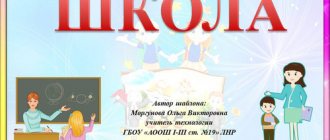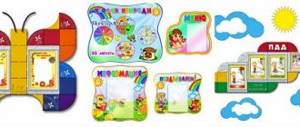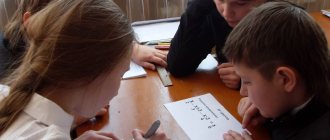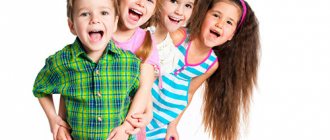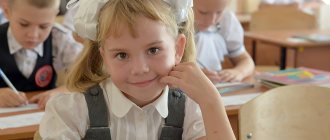Visual methods and techniques
The main principle of children's thinking is the principle of clarity. Therefore, in kindergarten classes it is necessary to use visual methods and techniques that will ensure the high efficiency of the educational process.
Observation
Observation is a systematic and purposeful perception by children of objects or environmental phenomena. For this process to be effective, the teacher must set a goal for contemplation for the children. Several options are possible.
1. Recognize, determine characteristics.
For example:
- in classes on the surrounding world while studying the topic “Flowers”, you can be asked to look at various plants and name only the flowers;
- in mathematics classes, when considering topics of comparing objects and establishing relationships between them, the task is to determine which objects are more and which are fewer; which tree is taller, which is lower, which fruit is shaped like a circle, etc.;
- in classes on speech development when studying the topic “Sound,” the teacher may suggest observing his pronunciation (how the lips are positioned, whether something prevents him from pronouncing the sound in a drawn-out manner).
2. Determine the nature of the changes or transformation of the object.
For example:
- in manual labor classes while playing with sand - determine how sand changes if it is wet;
- in classes on the surrounding world when studying seasonal changes in plants - observe what happened to the trees in the fall;
- in mathematics classes when studying the number 3 - establish what will change if you add one more to two subjects.
3. Establish the state of the object based on individual characteristics.
For example:
- in classes on the surrounding world when studying the topic “Parts of the day” - determine by the state of the sky and the position of the sun which part of the day has arrived;
- in classes on the surrounding world when studying the topic “Animals” - determine who it is by the type of paws (tail or ears).
Depending on the amount of time spent, observations can be long-term or short-term.
Demonstration
A demonstration is a visual display of an object. No verbal explanation in kindergarten classes will be effective if it is not accompanied by the demonstration of various visual aids. These include:
- objects, natural objects;
- subject or didactic pictures;
- book illustrations;
- reproductions;
- layouts.
The demonstration method covers the following teaching techniques:
- Demonstration of objects. Often such methodological techniques are used in kindergarten during art classes. For example, before asking children to draw an apple, they immediately show it to the children and ask them to take a good look and describe its shape, size, and color.
- Sample demonstration. For example, children are shown a sample of the application that they will perform or a sample of writing elements of letters, etc.
- Demonstration of how to perform actions. It is most often used in manual labor classes (how to roll out a “sausage” or make a ball out of plasticine, cut out a strip, glue a circle, etc.) and in physical education classes (how to bend over, jump, etc.).
- Demonstration of illustrations and reproductions. This technique is used when there is no possibility of direct perception of the object. For example, when studying the colors of the rainbow, if it is not in the sky at that time, children can be shown a picture in a book.
Observation and demonstration methods are most fully used during excursions and daily walks in the fresh air. They ensure the development of such a cognitive process as perception, the formation of visual-figurative and visual-effective thinking.
Great importance in the application of visual methods is given to the use of technical teaching aids (TSO) or a computer. This is becoming increasingly popular in the educational field and is used when there is a need to demonstrate a dynamic object or some process. Using TCO and a computer, they represent:
- filmstrips;
- slides;
- videos;
- computer programs.
For example, during a safety lesson, you could show a video about the rules for crossing the road. There are also now a large number of educational video games and programs, various cartoons with educational content, which are recommended for use in kindergarten classes.
Forms of education in kindergarten
⇐ PreviousPage 9 of 10Next ⇒Teaching is a way of organizing the pedagogical process, a two-way process of interaction between teacher and student, aimed at transferring and mastering the content of education by students.
Form of training - a way of organizing the activities of students, determining the number and nature of connections between participants in the learning process
Forms of training:
- individual – the teacher teaches one child (correctional and individual work);
- subgroup;
- group (frontal) - the teacher simultaneously teaches a group of children, within which everyone completes the educational task independently;
- independent* – child’s self-education in a developmental environment.
The form of organization of learning is a time-limited design of a separate link in the learning process, an external expression of specially organized activities of the teacher and students.
Forms of training organization:
1) educational situation = lesson (music + physical) = ECD (direct educational activity - according to SanPin);
An educational situation is a form of joint activity between a teacher and children, which is planned and purposefully organized by the teacher in order to solve certain problems of development, education and training in various types of children's activities.
Characteristic signs of classes:
— during the lesson, children are mastering the content of one of the sections of the curriculum;
— classes are held simultaneously with all children in the group;
- The teacher performs a leadership function in the classroom.
2) joint activities of a child with a teacher or a teacher with a child;
3) independent activity of children (in an educational environment).
Forms of child activity (FSES DO):
- play activities;
- communication activities;
- educational and research activities;
- perception of fiction and folklore;
- construction from different materials;
- self-service;
- basic household work;
- musical activity;
- motor activity.
54) The pedagogical process of kindergarten, its features and content.
The pedagogical process is a specially organized, purposeful interaction between children and a teacher, aimed at solving developmental and educational problems, built on the principles of didactics, having a clear structure, taking place in specially created conditions, in certain forms of its organization using methods and techniques, based on educational program.
Conditions (according to Federal State Educational Standards):
1) psychological and pedagogical;
2) personnel;
3) logistical;
4) financial.
Principles of didactics:
- The principle of the developmental and educational nature of education is aimed at the comprehensive development of the student’s personality and individuality.
- The principle of scientific content and methods of the educational process reflects the relationship with modern scientific knowledge.
- The principle of systematicity and consistency in mastering the achievements of science, culture, and experience gives a systematic character to educational activities, theoretical knowledge, and practical skills of the student.
- The principle of consciousness, creative activity and independence of students with the leading role of the teacher.
- The principle of visibility, the unity of the concrete and abstract, rational and emotional, reproductive and productive as an expression of an integrated approach.
- The principle of accessibility of training.
- The principle of the strength of learning outcomes and the development of students' cognitive powers.
- The principle of connecting learning with life. .
- The principle of a rational combination of collective and individual forms and methods of educational work.
The educational process in kindergarten (Loginova) is the introduction, combination and alternation of life processes, activities and education of children in different age groups, in individual, subgroup and frontal forms, as well as the creation of conditions necessary for the full development of the child.
Leading characteristics of the pedagogical process:
I. Focus
Pedagogical goals processes are formed by connecting the following 4 components at a single point:
— the value position of the teacher. The goals of the pedagogical process are determined by the characteristics of the pedagogical position, the interpretation of the philosophy of childhood, the uniqueness of the value attitude towards the child, and the understanding of the priority tasks of preschool education;
— goals of the educational organization. The goals of the pedagogical process are determined by those regulatory documents that contain the social order for what society wants to see as a graduate of a given educational organization;
- taking into account the capabilities, needs, interests and inclinations of children. Goals are determined by the individual characteristics of the pupils - the pedagogical process turns into the child’s individual educational route;
— taking into account the social needs of parents
II. Integrity
Integrity is the internal unity and consistency of all components, which characterizes the highest level of organization of the pedagogical process.
Essential characteristics of the holistic pedagogical process:
1) the integrity of the medical, psychological and pedagogical support of the child;
2) integrity of educational, educational and developmental tasks;
3) the integrity of the child’s life;
4) integrity in the process of interaction between the child and the world of adults;
5) integrity of the educational space
III. Availability of connections between participants;
The process of interaction between the teacher and children in the pedagogical process can be organized as:
- the process of influence (authoritarian approach - to form the child’s personality in accordance with a certain ideal model);
- process of inaction (liberal/formal type - the teacher only nominally performs his functions);
- process of assistance (person-oriented approach - maximum possible consideration of the subjective positions of participants in the pedagogical process - subject-subject relationships).
IV. Systematic and procedural (activity-based)
The pedagogical process as a system is characterized by the following features:
— integrity, manifested in the interconnectedness and interdependence of all components of the pedagogical process;
— structure (components: target, content, technological, effective, resource);
— openness (pedagogical process in preschool education is a system open to the sociocultural space, integrating into the system of lifelong human education);
— multiplicity of description (maybe described from different aspects).
Processuality – extension in time. Pedagogical process is a sequence of successive and diverse tasks that require solving.
There are a number of stages in the organization of the pedagogical process:
1) the stage of analyzing the situation, determining the pedagogical problem, designing solution options and choosing optimal conditions for implementation;
2) the stage of implementing the plan for solving the problem in practice, providing for the organization of activities and interaction of subjects of the pedagogical process;
3) the stage of analyzing the results of solving the problem.
55) Creating optimal conditions for children’s adaptation to kindergarten as a function of a preschool institution. Organization of the pedagogical process in early age groups.
Adaptation is an individual’s adaptation, independent and forced, to the conditions of the social environment and the result of this process; adaptation, getting used to new conditions.
Types of adaptation:
- biological (physiological) – restructuring of the body’s functional systems that occurs during the period of getting used to everything new;
- social – the ability to change one’s behavior in accordance with conditions.
The common task of us, educators and parents, is to help the child enter the life of kindergarten as painlessly as possible. For this you need:
— knowledge of the age and individual characteristics and capabilities of children;
- preparatory work in the family;
— development of uniform requirements for the child’s behavior, coordination of influences on him at home and in kindergarten.
The basic principles of work on adaptation of children are as follows:
1. Careful selection of teachers for the group being formed.
2. Gradual filling of groups (acceptance of 2-3 children per week).
3. Incomplete stay of the child during the initial period of adaptation (2–3 hours, possibility of staying with the mother).
4. Flexible regime for a child’s stay in kindergarten (free arrival time, additional days off).
5. Preservation of the baby’s existing habits in the first 2–3 weeks.
6. Daily monitoring of the child’s health, emotional state, appetite, and sleep in the first month (for this purpose, a so-called “adaptation sheet” is filled out for each child).
The specifics of the organization of the pedagogical process in early age groups are explained as follows. provisions:
- the regime of stay and activity of young children (free schedule for coming to the institution and inclusion in the pedagogical process), different types of activities are syncretic (a kind of non-differentiation);
- a feature of the development of young children (characterized by the underdevelopment of the volitional component, when the emotional component prevails; a high level of dependence of the developmental effect in any activity on physiological comfort, the inability to concentrate for a long time, etc.);
- the specificity of the implementation of a cognitive act through interaction with an adult with the accompanying role of the latter;
- the need for a unified developmental environment, which is simultaneously important for both the child and the adult (should help to master the necessary pedagogical methods of interaction with children).
The pedagogical process has a special emotional background for the joint activity of an adult and a child in the process of interaction, which helps to attract the attention of children, stimulate cognitive activity, create and support a situation of success for the child in activities.
The pedagogical process is holistically focused on the joint activities of adults and children.
In organizing pedagogical work with a young child, an activity approach is used (“action together”; activity is the driving force of development; amplification (enrichment) of child development).
Main characteristics of early childhood:
- Intensity / spasmodic physical and mental development.
- Increased vulnerability of the child’s body, insufficient morphological and functional maturity of organs and systems (fast pace of development against an unfavorable background - immaturity). Unstable emotional state.
- The relationship between physical and mental development (most pronounced at this age).
- Vivid specificity of psychophysiological and individual differences (level of activity, regularity of biorhythms, degree of comfort during adaptation of any kind; mood, intensity of reactions, sensitivity threshold, distractibility, perseverance and attention).
- Vivid satisfaction by the child of natural psychophysiological needs:
— sensorimotor need;
- need for emotional contact;
- needs for interaction and communication with adults (contact communication at 2-3 months, cognitive - 3-10 months, verbal-non-verbal - 10 months - 1.5 years, play and business - 1.5 - 3 years )
- Specificity of manifestation of nervous processes:
- ease of development of conditioned reflexes and difficulty in changing them;
- increased emotional excitability;
— difficulty switching processes of excitation and inhibition;
- increased emotional fatigue.
The specificity of the organization of the pedagogical process in early age groups is that the pedagogical process:
- represents sequentially changing situations of interaction between an adult and a child;
- has a special emotional background for the joint activity of an adult and a child in the process of their communication, which helps to attract the attention of children, stimulate cognitive activity, create and support a situation of success for the child in activities;
- focused on joint activities of adults and children.
The essence of the pedagogical process at an early age: pedagogical interaction as a process of organizing the life activity and communication of a child with adults and peers.
The methodology of educational activities with young children has its own specifics. It is associated with the development and behavior of children:
— Educational activities are carried out in a playful way, taking into account the decisive importance of the emotional factor of children.
— Strictly by subgroups: number of participants 6-8 children. The duration of the lesson does not exceed 8-10 minutes, always including a motor task.
— It is important to repeat classes, actions, skills, and knowledge acquired by a child do not become stable immediately and are easily destroyed. The theme is repeated, but with different material; or the same material, but the task changes.
⇐ Previous9Next ⇒
Practical methods and techniques
Practical methodological techniques in kindergarten classes help preschoolers to more deeply understand the surrounding reality. Their use allows the child to independently, through practical actions with objects, determine their basic properties and characteristics, establish the relationship between them, and understand the principle of their actions.
Practical methods provide a higher degree of knowledge acquisition than any other didactic techniques. A child will remember much better that lemon is sour if he tastes it himself, etc. There are four main methods.
Exercises
Exercises are the repeated repetition of various actions (practical or mental) of a certain content. As a result of performing the exercises, stable skills or abilities are formed. There are several types of exercises.
- Imitative exercises indicate actions according to a given pattern. They are used to practice correct articulation, to develop cultural and hygienic skills, etc.
- Constructive exercises are the implementation of tasks similar to those that the child performed under the guidance of the teacher. They are also called training ones. For example, they are necessary for the development of motor skills.
- Creative exercises involve the independent activity of a preschooler based on an interpretation or a new combination of skills he already has. For example, having skills in handling plasticine, a child can sculpt an object that is complex in its design.
The system of using the exercise method should be built on the principle of gradually complicating the conditions for their implementation.
Experiment
In kindergarten, only the simplest experiments are practiced, which help children gain new knowledge about the environment. During the experiment, preschoolers interact with objects to learn their properties and relationships with other objects.
The most effective technique is to organize the child’s search activities. You can offer the following tasks:
- determine which object sinks and which does not;
- turn snow into water;
- conduct experiments with clay;
- set the melting properties of the wax, etc.
Thanks to this method, the teacher forms visual and effective thinking in children.
Modeling
The modeling method is based on the principle of replacing a real object with a symbol, image, sign. In kindergarten, subject models (toys or substitute objects) or subject-schematic models are used (for example, when working with a nature calendar).
The use of this method contributes to the development of skills to compare, abstract, and generalize essential features.
Games
During didactic games, children are asked to recreate a specific situation, “live” it and gain some experience of acting in certain conditions. The use of this method presupposes the presence of gaming equipment, the distribution of roles and the implementation of gaming actions.
The use of didactic games in kindergarten includes the following methodological techniques:
- staging;
- asking riddles;
- introduction of competitive elements;
- organization of a game situation;
- performance of game actions by the teacher;
- miraculous appearance of objects.
The gaming method forms creative thinking, develops imagination, helps the child learn to behave at ease, and relieve psychological stress.
The essence of training and education of preschool children
Definition 1
Preschool age is the age period from 3 years before entering school (up to 7 years), during which the comprehensive development and formation of the child’s personality occurs.
During the period of preschool childhood, children actively develop analyzers, imagination, memory, speech, thinking, sensory knowledge of the world occurs, the formation of a worldview and attitude to the surrounding reality.
The period of preschool childhood is a unique and important stage in the development of a child’s personality. What is laid down in preschool age determines what a person will grow up and become in the future.
That is why the processes of upbringing and teaching preschool children are given such great importance. Despite the fact that training and education are implemented by different types of pedagogical activities, they are closely interconnected, and the effectiveness of the formation and development of personality largely depends on their combined application. It is impossible to educate a worthy person without the process of education, just as it is impossible to obtain an educated person without the process of education. Only education and training implemented in totality and unity are capable of forming an educated and well-mannered member of society.
Finished works on a similar topic
- Coursework Forms of training and education of preschool children 440 rub.
- Abstract Forms of training and education of preschool children 260 rub.
- Test work Forms of training and education of preschool children 230 rub.
Receive completed work or specialist advice on your educational project Find out the cost
Education by its nature is carried out as a process of interpersonal communication between the teacher and students. The learning process is the transfer of knowledge from teacher to child within the framework of a specially organized educational session. However, during the educational process, the child receives not only educational influence, but also some knowledge. Just as during an organized educational session, he receives not only knowledge, but also educational influence from the teacher.
Note 1
The effectiveness of education and training depends on correctly selected methods and means, as well as on the form of organization of the pedagogical process.
Verbal methods and techniques
Verbal methods provide live communication between the teacher and children. With the help of speech influence, the teacher can evoke an emotional response in preschoolers and encourage them to form their attitude towards the content of the knowledge being transmitted.
Story or reading
A story is an effective verbal method that allows you to present information in an accessible way for children. With the help of a story, you can put educational material into figurative form.
The teacher is encouraged to use literary works or write stories from personal life experience. The teacher, voicing a story for children, conveys his attitude to the story he is telling. The story can be used during any lesson. After listening to the story, the teacher must check the degree to which the preschoolers have mastered its content.
A more complex version of this method is for the child to retell the text he heard or compose his own statement based on a model or on a given topic.
